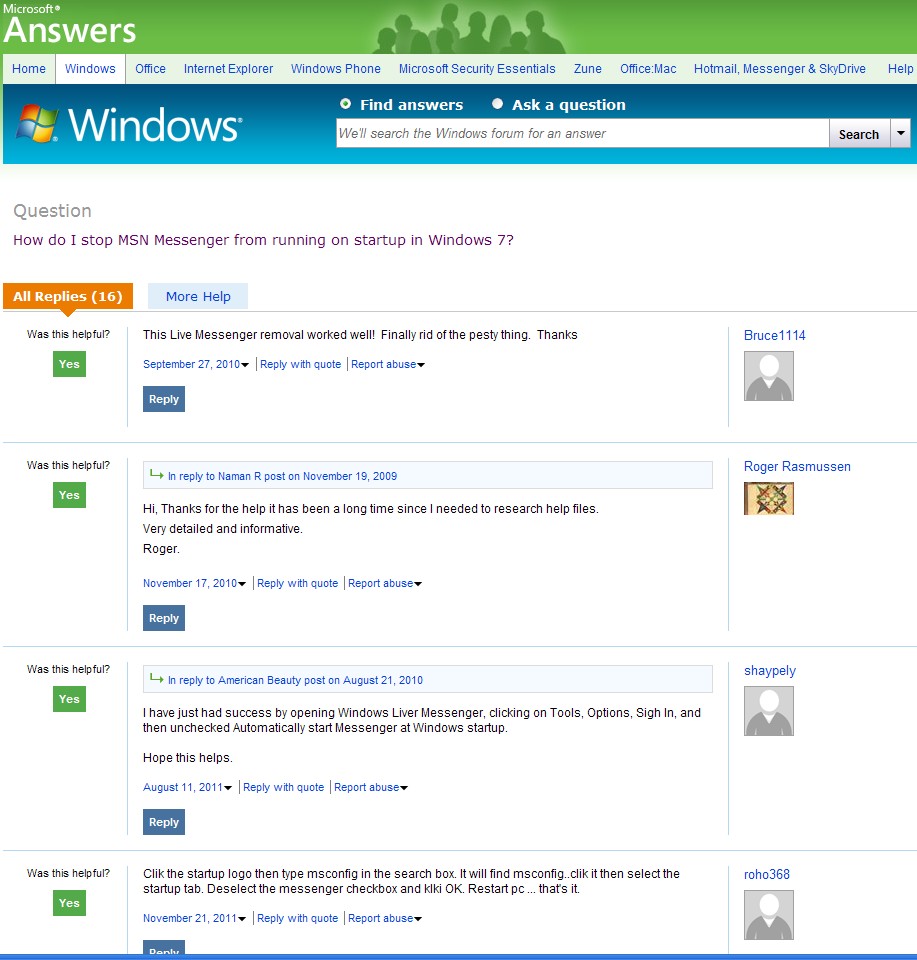ItsGeekToMe.co
The official home of It's Geek to Me on the web!
Issue #247: April 15, 2012
Q: I have a laptop and desktop, both running Windows 7. Windows Live Messenger has an icon on the taskbar of both. I can run MSCONFIG and take it out of the startup listing. Upon reboot it is gone. But, at the second reboot it returns. Do you have a suggestion where else to stop it from automatically running?
– Terry P.
Fort Walton Beach, Florida
A: I sure do, Terry: right in Windows Live Messenger itself. You’re trying to use MSCONFIG to do an end-run around the auto-start feature of WLM, but they use two different mechanisms to configure auto-starting. You can disable it with MSCONFIG, but it will come right back if WLM has been told to automatically start.
Here’s what you do: Run WLM and sign-in. Click on “Options” and then “Sign In”. Uncheck the box that says “Automatically run Windows Live Messenger when I log on to Windows”. Apply your selection, then back out of all the dialogs and reboot. Your system should run without WLM, however, I’ve read scattered reports about this not working any better than using MSCONFIG to disable it (thanks, Bill!). The next suggestion is, if you’re not using it, to just remove it from the system. After all, it can’t auto-start if it’s not installed, can it? You should find an entry for “Windows Live Essentials” in your Add/Remove Programs list in the Control Panel applet. Choose it, and click “Change/Remove”, and you’ll have the option to uninstall all or part of Windows Live Essentials, including Messenger.
Q: I lost my Windows Media Center program when computer was last corrected. How do I get it back???
– Name Accidentally Eaten By My Website
Destin, Florida
A: I’m going to assume that you mean that the shortcut for Media Center disappeared, and that the entire Media Center application did not get deleted. You can create a new shortcut pretty easily. Right-click in any blank spot on your Windows desktop and select New->Shortcut. In the Wizard that runs, the location of the item is C:\Windows\ehome\ehshell.exe. For a name, type “Shortcut to Windows Media Center”. When you finish the wizard, right-click on the shortcut and select “Properties”. Change the “Target” entry to read “%SystemRoot%\ehome\ehshell.exe” and click “Ok”.
Q: Love your column. Now – I have compiled many emails I have received from members of an organization I belong to. They are all ideas for teaching, classroom management, etc. I would like to put them in a manual and print the manual for general publication. Would I be violating any publication rights? Are things sent by email considered in the public domain? The manual would be for sale. Thank you for any info you can give me.
– Doris H.
Miramar Beach, Florida
A: You’re asking whether anything and everything sent by e-mail is automatically in the public domain? Well, I’m no lawyer, but think about what you’re asking. These days all manner of documents get sent by e-mail, including contracts, bills, medical information, and purchase orders, not to mention all the personal communications. It makes no sense to me that these things could in any way be considered to be in the public domain, simply because they were sent via e-mail. I mean, would you want the results of your last medical procedure to be public domain? What about an e-mailed credit card receipt for an online purchase? What if an author sends his manuscript to a publisher via e-mail? No, Doris, I think it’s pretty clear that the ownership of anything sent via e-mail isn’t automatically given up simply because of the method used to transmit it. I’d encourage you to contact the individuals of your organization to get permission before attempting to publish their collected works.
Bonus Web-only Content:
Ever wonder if Microsoft actually listens to all the feedback it gets from the (literally) BILLIONS of people that use its products? I sure have, especially since some of the worst problems don’t ever seem to go away. Check out the graphic below. This is a screen capture of part of a Microsoft Answer forum that I referenced to make sure I wasn’t blowing smoke at Terry P. in my answer to his question in today’s column.
Beside every entry in this forum is a little question that says “Was this helpful?” Do you notice anything? The only possible answer is “Yes”! Even if you wanted to, there’s no way to tell them it was useless. Is this Microsoft’s way of ensuring they only get positive feedback? That sure would explain a lot of things, wouldn’t it?
Until next week – good luck and happy computing!
– Geek

Leave a Reply
You must be logged in to post a comment.